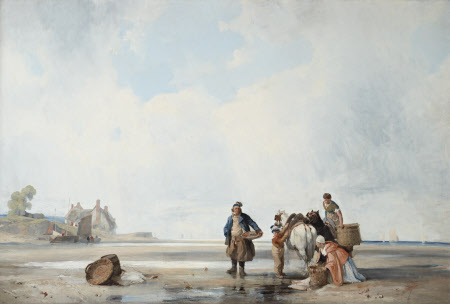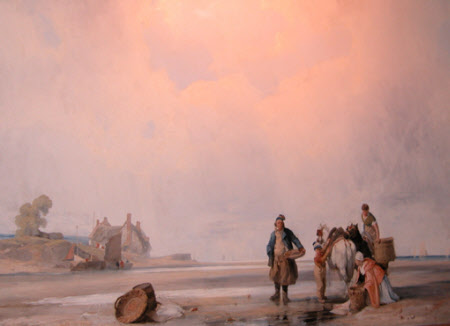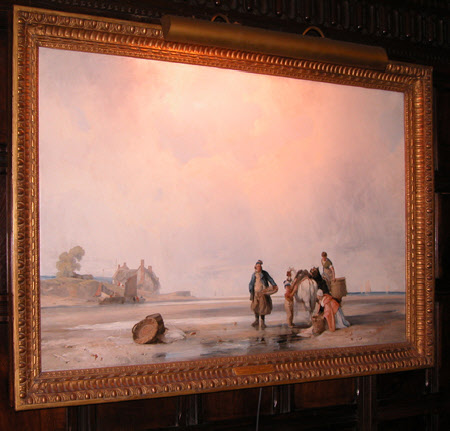Coastal Scene of Northern France
Richard Parkes Bonington (Arnold, Near Nottingham 1802 – London 1828)
Category
Art / Oil paintings
Date
1826
Materials
Oil on canvas
Measurements
800 x 1206 mm (31 1/2 x 47 1/2 in)
Place of origin
St Valery sur Somme
Order this imageCollection
Anglesey Abbey, Cambridgeshire
NT 515462
Caption
This picture was offered to the Louvre soon after Bonington’s death, but it was refused, with the remark that the painter’s success with the public and among collectors was not sufficient for it to merit a place in the galleries. Apparently Bonington had painted the forelegs of the grey pony, ‘but being dissatisfied, he painted them over with a light tint matching that of the ground. Then he did no more to it, and the present picture remains thus incomplete.’ The location of the picture has been much-debated. The woman’s costume and type of house suggest a location in Artois, rather than Picardy or Normandy, as often claimed. It seems probable, however, that it does not show a specific place, but is rather a synthesis of many sketches.
Summary
Oil painting on canvas, Coastal Scene of Northern France by Richard Parkes Bonington (Arnold, Near Nottingham 1802 – London 1828), 1826. A wide stretch of sand with a group of four fisherfolk (a man, two women and a young boy) and their two ponies in the foreground on the right; the women are loading basket-panniers onto the ponies, the boy holds one of trhe ponies and the man holds a basket-tray on his left hip. Centre right on the sand is a wooden barrel with a wicker tray leaning on it and behind to the left in the distance is a Cottage and tree on a promontory. Distant view of the sea on the right. Two thirds of the painting is occupied by a large expanse of cloudy sky.
Full description
There were three British landscape - and subject - painters in the earlier part of the 19th century whom the French particularly admired: Constable, Bonington, and John Martin. It is therefore very singular that, although all three exhibited at the Salons, and despite the fact that Bonington actually lived in France, even sharing a studio at one point with Delacroix, and had many clients who were French, or who (like Lewis Brown) had their domicile in France, no major work by any of them is to be found in a French public collection . The present painting was perhaps one of the greatest missed opportunities. Its original owner, Bonington's close friend Charles, baron Rivet, offered it to the Louvre shortly after the artist's death, but it was refused by the Director, the comte de Forbin, on the grounds that the artist's "successes with the public and among collectors do not constitute a sufficient title to admission into the galleries of the Louvre" . Rivet's retort was to say that he would instead bequeath the picture to his family, with the proviso that it was never to be given or sold to the Louvre or any other museum. Forbin may also have been influenced by the fact that the painting is not quite finished. It possesses the singularity that the white horse has no forelegs. According to Dubuisson & Hughes, Bonington had indicated them: "but being dissatisfied he painted them over with a light tint matching that of the ground. Then he did no more to it, and the picture remains thus incomplete." It was only Charles Damour who added legs to the horse, in his soft-ground etching of the picture of 1852. Nor were the face and headgear of the woman crouching on the sand completed. There are also a number of visible pentimenti in the picture, including a building painted out at the left, the original positioning of a figure similar to the central fishermen with something at his feet painted out to the right of him, and a more substantial figure than the girl now seated on the bay horse also painted out. All these things indicate that the picture must have given the artist a certain difficulty, yet the final result seems effortless, and he must evidently have considered that he was in danger of disturbing this effect by continuing to work at it. As his friend Delacroix later noted: "He altered his pictures because he had such facility that everything he put on canvas was charming. Yet the details did not always hold together, and his tentative efforts to get back the general effect sometimes caused him to abandon a picture after he had begun it" . Baron Rivet (who was also a friend of Delacroix in his youth) was evidently not disturbed by this non finito, whereas Auguste, comte de Forbin (1777-1841), a former fellow-pupil of both Constantin d'Aix and David with Granet, from whom he was later described as "insépérable", and by whom his own chiaroscuro studies of buildings and ruins (no less than seven of which he did not blush to give to the Louvre) were much influenced , was out of sympathy with this approach to painting - as indeed Bonington's friend Delacroix himself was to turn against it in later years . Forbin may have had additional cause for rancour, in that Auguste Jal, when reviewing Bonington's Venetian pictures in the Salon of 1827, had written: "The figures are only sketched, but so grandly! - I prefer this manner of figure drawing to Granet's" . The attempted donor of this painting, Jean-Charles, called Charles, baron Rivet (1800-1872), also began life as an artist, or at least as the frequenter of artists' studios, but ended it as a politician who lent his name to the proposition Rivet (1871), which gave the title of President to the head of the Third Republic. The son of a Napoleonic prefect (whence his title), he became and remained the intimate friend of both Bonington and Delacroix - the latter, indeed, wanted to make him his heir - frequenting their studios in Paris, and having them to stay at his family château at Mantes. He was Bonington's companion on, and probably financed, his visit to North Italy in 1826, and quotations from his letters from that journey are as precious a source for our knowledge of Bonington's personality, as those from his unpublished essay on Delacroix are for the impression created by the latter in his youth. He and his descendants owned - and some still own - a variety of works by Bonington. A set of soft-ground etchings of ten of them - including the present picture as no.9 - were made by Charles Damour, and published as Oeuvres inédites de Bonington in 1852. There is some uncertainty as to the site shown in this painting, and consequently also as to its date. Contrary to what was stated in the catalogue of the recent Bonington exhibition, the title Near the Bay of the Somme is far from traditional, and does not originate with its first owner, Charles Rivet, or his heirs . Telling his story of its rejection by the Louvre, René-Paul Huet called it: "une Plage normande". Since his father, the painter Paul Huet, had gone sketching along the Seine (which debouches in Normandy) in 1825, and planned a trip to Normandy with Bonington in 1828, which was aborted by the latter's terminal illness, he could have been speaking from first-hand information. This was also the title used by Dubuisson, who first related René-Paul Huet's story, in both 1909 and 1924, when the picture still belonged to descendants of Charles Rivet . The grounds for instead called the painting Near the Bay of the Somme - or, more specifically, Near St.-Valéry-sur-Somme - rest on supposed similarities (invisible to the writer) with the site shown in a watercolour whose identification seems equally tenuous . There are, however, certain admissible similarities with other oil paintings of broad beaches with uncluttered horizons, all of which are said to show the coast of Picardy . One of these, the picture in the Ferens Art Gallery, Hull, which is tentatively identified with a painting in [?Sir Henry] Webb's sale in Paris in 1837, called Le port de Saint-Valéry (Somme), bateaux, pêcheurs sur le rivage, has a teamed pair of dark and white horses with paniers, similar to those in the present painting . In two other respects, however, the present picture differs from the coast scenes supposed to represent Picardy: the buildings are thatched not tiled, and the headgear worn both by the women and by the man and boy differs from the traditional Picard types, as shown in Bonington's own paintings and drawings, particularly the woman's (even allowing for its being unfinished). The painting that has figures with the most closely resembling forms of headgear is also the one that seems stylistically closest to the present picture: that in the Yale Center for British Art, which is plausibly identified both with the exhibit with which Bonington won a gold medal at the Salon of 1824 - Marine. Des pêcheurs débarquent leur poisson - and with the painting that, by the time that it was in H.A.J. Munro of Novar's sale in 1857, had acquired the title, A Fishmarket near Boulogne . Thatched, rather than tile-roofed - cottages appear (in a more credible context than beside the sea, it must be said), in a painting at Knightshayes (NT) evidently related to one that was also shown at the 1824 Salon, as Étude de Flandre, and that has plausibly been identified with the Shipping on the Canal at Calais: Morning effect that was in [?Sir Henry] Webb's sale in Paris in 1837 . These two sets of affinities both link the locus of the present picture with Artois, rather than with Picardy or Normandy. Bonington visited Artois twice: in 1823, as part of an extensive exploration of the Channel coast from Bruges down to Normandy, in connection with a commission from J.F. d'Ostervald, for views to be published as aquatints in his Excursions sur les côtes et dans les ports de France; and in 1824, when he spent most of what he called "the happiest year of my life" in Mme. Perrier's boarding-house in Dunkerque, much of it with his bosom friend and fellow-artist, Alexandre Colin (1798-1873). Removal from the distractions of Paris evidently enabled him to get a lot of work done, and there is no indication that he travelled much. This picture - if it was indeed painted then - was thus no doubt the synthesis of many sketches, and of impressions in his mind, rather than a view of a particular location - as the pentimento of a building would also suggest. That also accords better with the very general titles that Bonington himself gave to most of the coastal scenes that he exhibited - Marine, Une plage sablonneuse, French Coast Scenery, and French Coast, with Fishermen, &c. -or that they were given in his and his parents' posthumous sales: it was only the topographical mania of the British that has insisted on investing them with the titles of specific locations long after the event. (i) Proof of this statement will be found in the works by which these artists were recently represented in exh. cat. d'outre-Manche: l'art britannique dans les collections publiques françaises, Musée du Louvre, 1994. (ii) A. Dubuisson & C.E. Hughes, Richard Parkes Bonington: His Life and Work, 1924, pp.119-120, giving a fairly faithful translation of the story as originally told by A. Dubuisson in 'Richard Parkes Bonington', La Revue de l'Art Ancien et Moderne, vol. XXVI, Nov. 1909, pp.385-86, n.1. (iii) The Journal of Eugène Delacroix, ed. Herbert Wallington, transl. Lucy Norton, 1951, pp.324-25, entry for 31 December 1856; cf. Journal de Eugène Delacroix, ed. Paul Flat & René Piot, Paris, vol.III (1895), p.188. (iv) Op.cit., pp.220, 324 & 371; entries for 22 Nov. 1853, 31 Dec. 1856, and 29 Oct. 1857. (v) Esquisses, croquis, pochades, ou tout ce qu'on voudra, sur le salon de 1827, Paris, 1828, p.237; quoted in exh. cat. Bonington, 1991-92, p.72. (vi) This title, indeed, only seems to have been used for the first time when the picture was exhibited at Agnew's in 1962, in a geographically impossible yoking of the Somme with Normandy. (vii) 'Richard Parkes Bonington', La Revue de l'Art Ancien et Moderne, XXVI, Nov. 1909, pp.384-86 & fig.; Dubuisson & Hughes, 1924, p.118 (in the pl. opp. p.120 it is admittedly just called Coast Scene). (viii) Exh.cat.cit., no.9. (ix) Exh.cat.cit., nos. 49, 50, 76, 110 & 120. (x) Exh.cat.cit., no.119. But it should be noted that the two sketches - whether or not they are both by Bonington - that are associable with this picture, and that belonged to Baron Rivet's daughter, are both baldly called Coast Scene in the captions to the plate of them in Dubuisson & Hughes (opp.p.56). (xi) Exh.cat.cit., no.29 & cover. (xii) Exh.cat.cit., no.31. (adapted from author's version/pre-publication, Alastair Laing, In Trust for the Nation, exh. cat., 1995)
Provenance
Bequeathed by Bonington to his friend Baron Charles Rivet (1800-1872), statesman, who offered it to the Louvre after Bonington's death, but it was refused, possibly because it appeared unfinished; thence to his daughter Mme de Catheu/Mme de Salvandy; his grand-daughter Mme Paul Tiersonnier; Bought by M. Eugene Feral from Madame Salvandy; Galerie Drouin, Paris 1938; Mr Spector. Acquired before 1962 by 1st Lord Fairhaven. Bequeathed to the National Trust by Huttleston Rogers Broughton, 1st Lord Fairhaven (1896-1966) with the house and the rest of the contents.
Marks and inscriptions
Verso: Inscribed on label on back of frame: 4023 Verso: Inscribed on label on back of frame: W.O. / 9380 / 2 Verso: Inscribed on label on back of frame:The British Council / Fine Arts Department/ Artist Bonington / Title The Mouth of the Somme / Collection Verso : Inscribed on label on back of frame:Anglesey Abbey/ Exhibition Europalia, Brussels, 1973/ Catalogue No.7 Verso: Inscribed on label on back of frame: Loan Exhibition / of / Pictures and Drawings / by R. P.Bonington / (In Aid of the King's Lynn Festival Fund) / Agnew's February-March 1962 / Title Normandy Coast Scene: The Mouth of/ the Somme / Owner The Lord Fairhaven/ No. in Exhibition 2 Verso: Inscribed on label on back of frame:7100 Verso: Inscribed on label on back of frame:7101 Verso: A stamp on the stretcher reads:. . . Position/ Paris. Verso: There are other faint writings on the stretcher in chalk and ink one of which reads: 4170 Recto: Inscribed on Gilt tablet affixed to bottom of frame: 1802 Richard Parkes Bonington 1828. La Cote Normande Embouchure de la Somme. Painted in 1826. Given by the artist to Baron Charles Rivet. Engraved by C. Damour. Exhibited at the B.F.A.C., 1937. From the Rivet Family Collection. Exhibited Agnews, 1962.
Makers and roles
Richard Parkes Bonington (Arnold, Near Nottingham 1802 – London 1828), artist
Exhibition history
Turner and the Sea, National Maritime Museum, Greenwich, 2013 - 2014, no.66
References
Dubuisson 1909 A. Dubuisson, Richard Parkes Bonington, pt. II, p.120; La Revue de l'Art Ancien et Moderne, vol. XXVI, Nov 1909, pp.384-86, with. fig. Dubuisson and Hughes 1924 A. Dubuisson and C. E. Hughes, Richard Parkes Bonington his Life and Work, 1924, p.118 (as ‘Coast Scene’): Edwards 1937 Ralph Edwards, Burlington Magazine, vol. lxxi, no. CDXII, July 1937, pp.35-7 Shirley, 1940: Hon. Andrew Shirley, Bonington, London, 1940, pp.99-100 and pl. A Oppé 1941 Paul Oppé, review, Burlington Magazine, vol. LXXIX, Sept 1941, Review of The Hon. Andrew Shirley's 'Bonnington', 1940 E le Roy & Co, 1944: letter dated 19 February 1944, from E. le Roy & Co., 18 Rue de Messine, Paris., Translation of letter: Antique Collector, December 1951: The Antique Collector, Vol.22, No.6, December, 1951, p.234 Sutton 1962 Denys Sutton, 'Bonington, A Radical Lyrist', Apollo, lxxvi, March 1962, pp.58-62, p.61, fig. 3: Cornforth, 1962: John Cornforth, Country Life, 1 Mar 1962, p.448 & fig. 1



